Adi Nes | |
|---|---|
 | |
| Born | 1966 (age 57–58) |
| Nationality | Israeli |
| Known for | photography |
Adi Nes (Hebrew: עדי נס; born 1966) is an Israeli photographer. He has had solo exhibitions at Wexner Center for the Arts in Columbus, Ohio[1] and the Legion of Honor in San Francisco.[2]
Life and career
Adi Nes was born in Kiryat Gat. His parents are Jewish immigrants from Iran.[3][4] He is openly gay.[5] Nes studied photography at Bezalel Academy of Arts and Design in Jerusalem in 1989 to 1992.
Nes' series "Soldiers" mixes masculinity and homoerotic sexuality, depicting Israeli soldiers in a fragile way.[6]
Nes' "The Last Supper" recalls Leonardo da Vinci's The Last Supper, replacing the characters with young male Israeli soldiers.[7] A print sold at auction in Sotheby's for $102,000 in 2005,[8] and another for $264,000 in 2007.[9]
Nes' early work has been characterized as subverting the stereotype of the masculine Israeli man by using homoeroticism and sleeping, vulnerable figures.[10] He regularly uses dark-skinned Israeli models.[11] The models' poses often evoke the Baroque period. Nes has said that the inspiration for his photography is partially autobiographical:
My staged photographs are oversized and often recall well-known scenes from Art History and Western Civilization combined with personal experiences based on my life as a gay youth growing up in a small town on the periphery of Israeli society.
— Adi Nes[12]
Nes lives and works in a small town at the north of Tel Aviv, he and his partner have four surrogate children.[3] His work is currently sold through Jack Shainman Gallery in New York City and Praz-Delavallade in Paris and Los Angeles. In January 2007, he premiered a new series echoing Biblical stories.[13]
Solo exhibitions
- Between Promise and Possibility: The Photographs of Adi Nes, Legion of Honor, San Francisco, 2004[2]
- Biblical Stories, Wexner Center for the Arts, Columbus, Ohio, 2008[1]
Awards and prizes
- 1993: Ministry of Education Council for Prize for Completion of Work, Ministry of Culture and Education
- 1999: The Minister of Education, Culture and Sport Prize, The Ministry of Education, Culture and Sport
- 2000: Nathan Gottesdiener Foundation, The Israeli Art Prize, Tel Aviv Museum of Art, Tel Aviv
- 2003: The Constantiner Photographer Award for an Israeli Artist, Tel Aviv Museum of Art
- 2005: Chosen as an outstanding artist of the Israel Cultural Excellence Foundation.
- 2013: Culture & Sport Minister's Prize for Artists in the Visual Arts[16]
Gallery
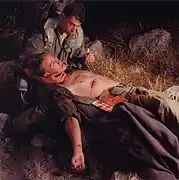 Untitled, from series "Soldiers", 90 x 90 / 140 x 140 cm., 1995.
Untitled, from series "Soldiers", 90 x 90 / 140 x 140 cm., 1995.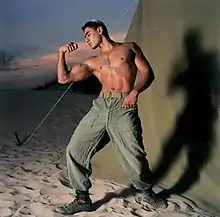 Untitled, from series "Soldiers", 90 x 90 / 140 x 140 cm., 1996.
Untitled, from series "Soldiers", 90 x 90 / 140 x 140 cm., 1996. Untitled, from series "Soldiers", 90 x 90 / 140 x 140 cm., 1998.
Untitled, from series "Soldiers", 90 x 90 / 140 x 140 cm., 1998.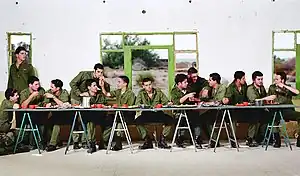 Untitled (The Last Supper), from series "Soldiers", 90 x 148 / 185 x 235, 1999.
Untitled (The Last Supper), from series "Soldiers", 90 x 148 / 185 x 235, 1999. Untitled, from series "Boys", 100 x 100 / 140 x 140 cm., 2000.
Untitled, from series "Boys", 100 x 100 / 140 x 140 cm., 2000.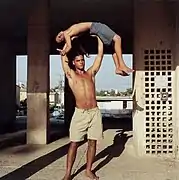 Untitled, from series "Boys", 100 x 100 / 140 x 140 cm., 2000.
Untitled, from series "Boys", 100 x 100 / 140 x 140 cm., 2000. Untitled (Narcissus), from series "Boys", 100 x 100 / 140 x 140 cm., 2000.
Untitled (Narcissus), from series "Boys", 100 x 100 / 140 x 140 cm., 2000.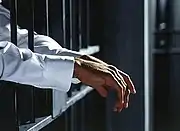 Untitled, from series "Prisoners", 60 x 82 / 90 x 123 cm., 2003.
Untitled, from series "Prisoners", 60 x 82 / 90 x 123 cm., 2003.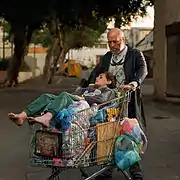
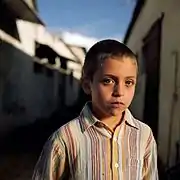 Untitled (Joseph), from series "Biblical Stories", 100 x 100 / 140 x 140 cm., 2004.
Untitled (Joseph), from series "Biblical Stories", 100 x 100 / 140 x 140 cm., 2004.
References
- 1 2 "Biblical Stories by Israeli Artist Adi Nes on View This Winter - Wexner Center for the Arts". wexarts.org. April 2008. Retrieved 2023-05-06.
- 1 2 Hamlin, Jesse (22 April 2004). "His photos are lovely, erotic, even a bit disturbing. Adi Nes uses classical composition to portray Israeli soldiers". SFGATE. Retrieved 2023-05-06.
- 1 2 Seymour, Tom. "Adi Nes on "challenging stereotypical masculine imagery"and "allowing my subjects to be sensitive" - 1854 Photography". www.1854.photography. Retrieved 5 May 2023.
- ↑ "Underpinnings of Greek Tragedy in Israel". 2012-07-17.
- ↑ "Adi Nes - Jack Shainman Gallery".
- ↑ "Adi Nes on masculinity, sexuality and war". Phaidon.com. Retrieved 2017-11-21.
- ↑ 'Real Time' at Israel Museum: Artists Absorb Their Country's Heritage, and Move On - New York Times
- ↑ Sothebys' (Requires free registration) Includes commentary on the piece.
- ↑ Bloomberg.com
- ↑ Hamlin, Jesse, Adi Nes uses classical composition to portray Israeli soldiers, SF Gate, April 22, 2004.
- ↑ Somkze, Catherine, Meeting with Adi Nes / Biblical Stories, Eyemazing, February 2006.
- ↑ Adi Nes Archived December 31, 2007, at the Wayback Machine on the Israel Center in San Francisco.
- ↑ Schalit, Joel, Portrait of the Artist as Political Philosopher, Tikkun.org, July/August 2006.
- ↑ "Information Center for Israeli Art | The Israel Museum, Jerusalem". museum.imj.org.il. Retrieved 5 May 2023.
- ↑ "Adi Nes - Biography". Ben Uri Gallery and Museum. Retrieved 5 May 2023.
- ↑ "Adi Ness | Contemplative Contemporary Photographer | Tiroche Auctions". לתירוש. Retrieved 5 May 2023.
General references
- Gal, Nissim1. 2010. "The Language of the Poor: Bible Stories as a Critical Narrative of the Present." Images: Journal of Jewish Art & Visual Culture 4, no. 1: 82-108. Art & Architecture Source, March 27, 2017.